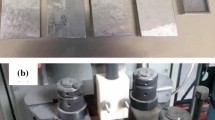Abstract
Ni-base superalloys are a class of materials with high temperature excellent tensile, creep, and corrosion properties that have widespread applications in manufacturing hot parts of gas turbines. Application of cross wedge rolling (CWR) process for manufacturing Ni-base superalloys is of least investigated areas. In this article, the effects of CWR tool parameters on formability of Nimonic® 80A and Nimonic® 115 wrought superalloys are presented. The normalized Cockcroft-Latham model is adopted through finite element analysis to predict the occurrence of internal burst. The analytical results are validated through comparing them with experimental data. Comprehensive results of the effects of various CWR tool parameters on formability of Nimonic® 80A and Nimonic® 115 are presented. The results show that in some cases for Nimonic® 115, regardless of the stretching angle value (β), the internal burst fails the process. The results also indicate that Nimonic® 80A displays a relatively good ductility in low wedge angles and low stretching angles without suffering internal bursts, leading to sound part.
Similar content being viewed by others

References
Pater Z (2000) Theoretical and experimental analysis of cross wedge rolling process. Int J Mach Tool Manuf 40(1):49–63
Dong Y, Lovell M, Tagavi K (1998) Analysis of interfacial slip in cross-wedge rolling: an experimentally verified finite-element model. J Mater Process Technol 80–81:273–281
Pater Z (1997) Theoretical method for estimation of mean pressure on contact area between rolling tools and workpiece in cross wedge rolling processes. Int J Mech Sci 39(2):233–243
Lovell MR (2001) Evaluation of critical interfacial friction in cross wedge rolling. J Tribol-Trans ASME 123(2):424–429
Pater Z (1999) Numerical simulation of the cross wedge rolling process including upsetting. J Mater Process Technol 92:468–473
Deng Z, Lovell MR, Tagavi KA (2001) Influence of material properties and forming velocity on the interfacial slip characteristics of cross wedge rolling. J Manuf Sci Eng 123(4):647–653
Li Q, Lovell MR, Slaughter W, Tagavi K (2002) Investigation of the morphology of internal defects in cross wedge rolling. J Mater Process Technol 125–126:248–257
Pater Z (2003) Tools optimisation in cross wedge rolling. J Mater Process Technol 139(1):153–159
Li Q, Lovell MR (2004) The establishment of a failure criterion in cross wedge rolling. Int J Adv Manuf Technol 24(3–4):180–189
Wang M, Li X, Du F, Zheng Y (2004) Hot deformation of austenite and prediction of microstructure evolution of cross-wedge rolling. Mater Sci Eng A-Struct Mater 379(1):133–140
Pater Z, Bartnicki J, Samolyk G (2005) Numerical modelling of cross-wedge rolling process of ball pin. J Mater Process Technol 164:1235–1240
Lee HW, Lee GA, Yoon DJ, Choi S, Na KH, Hwang MY (2008) Optimization of design parameters using a response surface method in a cold cross-wedge rolling. J Mater Process Technol 201(1):112–117
Jia Z, Zhou J, Ji J, Lei Z, Xiang D, Sun X (2013) Influence analysis of area reduction for necking in twice-stage cross wedge rolling. Int J Adv Manuf Technol 66(9–12):1407–1413
Zhou J, Xiao C, Yu Y, Jia Z (2013) Influence of tool parameters on tool wear in two-roll cross-wedge rolling. Int J Adv Manuf Technol 65(5–8):745–753
Hayama M (1979) Optimum working conditions in the cross rolling of stepped shaft. J Mech Work Technol 3(1):31–46
Pater Z, Weroñski W, Kazanecki J, Gontarz A (1999) Study of the process stability of cross wedge rolling. J Mater Process Technol 92–93:458–462
Dong Y, Tagavi KA, Lovell MR (2000) Analysis of interfacial slip in cross-wedge rolling: a numerical and phenomenological investigation. J Mater Process Technol 97(1):44–53
Reed RC (2006) The superalloys fundamentals and applications. Cambridge University Press
Betteridge W, Heslop J (1974) The Nimonic alloys and other nickel-base high-temperature alloys. Edward Arnold Press
Wright DC, Smith DJ (1986) Forging of blades for gas turbines. J Mater Sci Technol 2(7):742–747
Brooks JW (2000) Forging of superalloys. J Mater Des 21(4):297–303
DEFORM-3D User’s Manual (2009) Scientific Forming Technologies Corporation
Shahriari D, Sadeghi MH, Akbarzadeh A, Cheraghzadeh M (2009) The influence of heat treatment and hot deformation conditions on γ′ precipitate dissolution of Nimonic 115 superalloy. Int J Adv Manuf Technol 45(9–10):841–850
Jeong HS, Cho JR, Park HC (2005) Microstructure prediction of Nimonic 80A for large exhaust valve during hot closed die forging. J Mater Process Technol 162:504–511
Freudenthal AM (1950) The inelastic behavior of solids. Wiley
Oyane M (1972) Criteria of ductile fracture strain. Bull JSME 15(90):1507–1513
Rice JR, Tracey DM (1969) On the ductile enlargement of voids in triaxial stress fields. J Mech Phys Solids 17(3):201–217
Cockcroft MG, Latham DJ (1968) Ductility and the workability of metals. J Inst Met 96(1):33–39
Landre J, Pertence A, Cetlin PR, Rodrigues JMC, Martins PAF (2003) On the utilisation of ductile fracture criteria in cold forging. Finite Elem Anal Des 39(3):175–186
Quan GZ, Wang FB, Liu YY, Shi Y, Zhou J (2013) Evaluation of varying ductile fracture criterion for 7075 aluminum alloy. T Nonferrous Metal Soc 23(3):749–755
Takuda H, Mori K, Hatta N (1999) The application of some criteria for ductile fracture to the prediction of the forming limit of sheet metals. J Mater Process Technol 95(1):116–121
Ozturk F, Lee D (2004) Analysis of forming limits using ductile fracture criteria. J Mater Process Technol 147(3):397–404
Nicolaou PD, Semiatin SL (2005) An analysis of cavity growth during open-die hot forging of Ti-6Al-4 V. Metall Mater Trans A 36(6):1567–1574
Kukuryk M (2012) Analysis of deformation and damage evolution in hot elongation forging. Arch Metall Mater 55(2):417–424
Author information
Authors and Affiliations
Corresponding author
Rights and permissions
About this article
Cite this article
Mirahmadi, S.J., Hamedi, M. & Ajami, S. Investigating the effects of cross wedge rolling tool parameters on formability of Nimonic® 80A and Nimonic® 115 superalloys. Int J Adv Manuf Technol 74, 995–1004 (2014). https://doi.org/10.1007/s00170-014-6047-5
Received:
Accepted:
Published:
Issue Date:
DOI: https://doi.org/10.1007/s00170-014-6047-5



